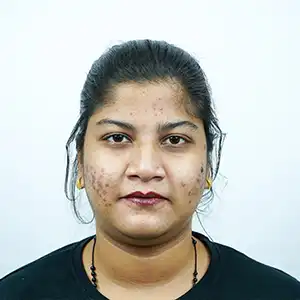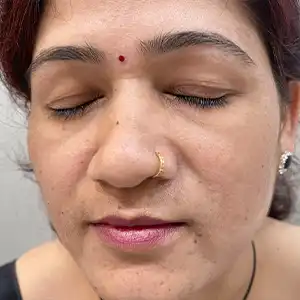

Introduction
Dark spots, also known as hyperpigmentation, can develop due to a variety of reasons, leaving patches of skin darker than the surrounding areas. Whether they appear as age spots, sun spots, or post-acne scars, dark spots can be frustrating. At Urban Skin and Hair Clinic, we offer advanced Dark Spot Treatments that target these pigmented areas, leaving your skin clearer, more even-toned, and radiant.
What is Dark Spot?
Dark spots are areas of the skin that are darker than the surrounding skin. These spots can range in size and appearance, and they commonly occur on the face, hands, and shoulders. Dark spots are caused by an excess production of melanin, the pigment responsible for skin color. While dark spots are not harmful, they can be a cosmetic concern, affecting the overall appearance of the skin.
Causes of Dark Spots
Several factors can contribute to the development of dark spots:
- Sun Exposure: Prolonged exposure to UV rays stimulates melanin production, leading to sun spots or age spots.
- Hormonal Changes: Conditions like pregnancy or the use of birth control pills can cause hormonal imbalances that trigger melasma, a type of pigmentation on the face.
- Post-Acne Scarring: After acne heals, it may leave behind dark spots or hyperpigmentation, especially in individuals with darker skin tones.
- Skin Inflammation: Any injury to the skin, such as cuts, burns, or allergic reactions, can lead to post-inflammatory hyperpigmentation, causing dark spots to form.
- Aging: As we age, skin turnover slows down, and the accumulation of sun exposure over time may lead to the development of age spots.
- Genetics: A family history of pigmentation issues can make you more prone to developing dark spots.
- Use of Harsh Skincare Products: Some skincare products can irritate the skin and lead to pigmentation changes if not used properly.
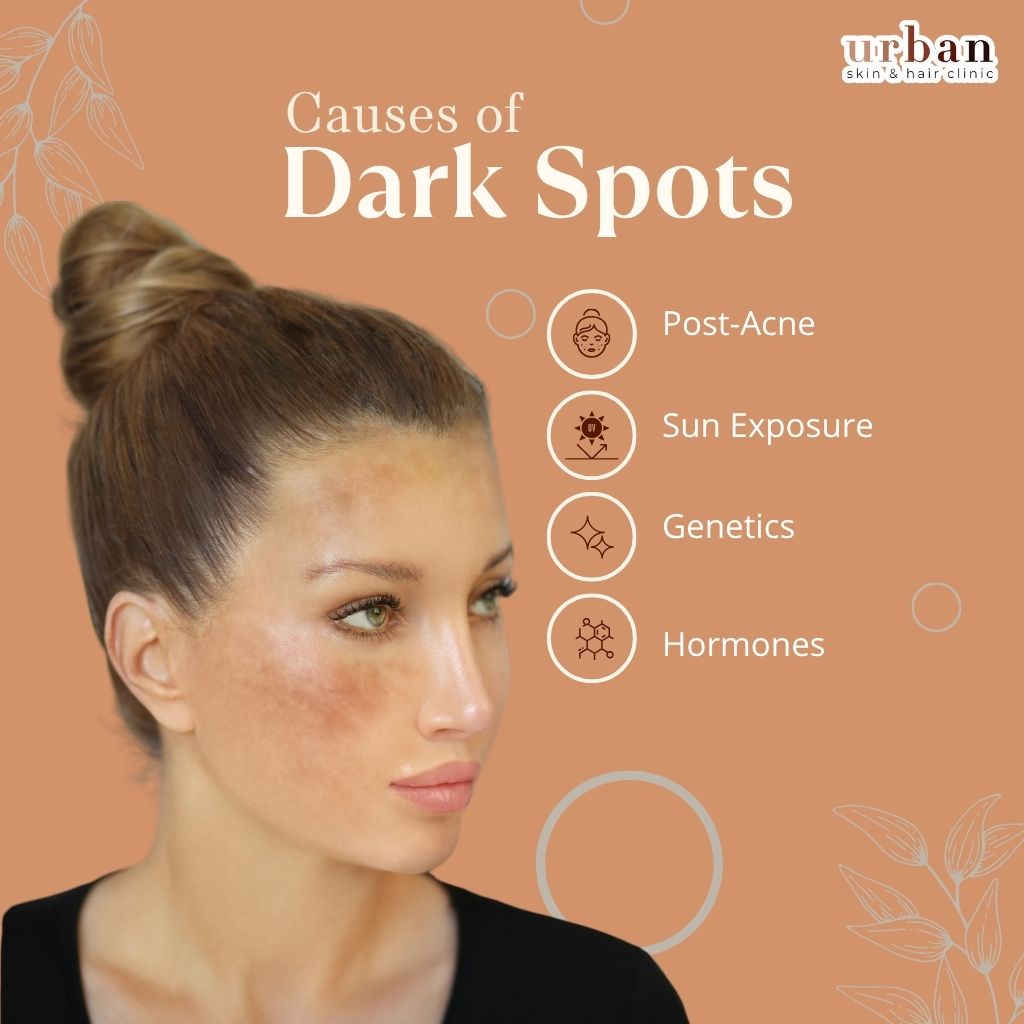
Treatment Benefits
✅ Reduces Hyperpigmentation: Targets dark spots and helps lighten them over time.
✅ Evens Skin Tone: Helps restore a more uniform skin tone and texture.
✅ Prevents Further Darkening: Helps prevent new dark spots from forming by addressing the root causes of pigmentation.
✅ Non-Invasive and Safe: Our treatments are gentle, ensuring minimal downtime and safe application on all skin types.
✅ Improves Skin Texture: Along with lightening dark spots, these treatments enhance overall skin smoothness and radiance.
✅ Boosts Confidence: Clearer, even-toned skin enhances self-esteem, leaving you feeling confident and radiant.
Before-After Results Alopecia Areata
Our patients experience noticeable improvements after a few sessions. Dark spots gradually fade, leaving behind clearer, more even-toned skin. Many clients see a reduction in hyperpigmentation within the first few weeks, and continued treatment can result in a more even complexion. Before-and-after photos from our patients highlight the visible reduction in dark spots and enhanced skin texture.
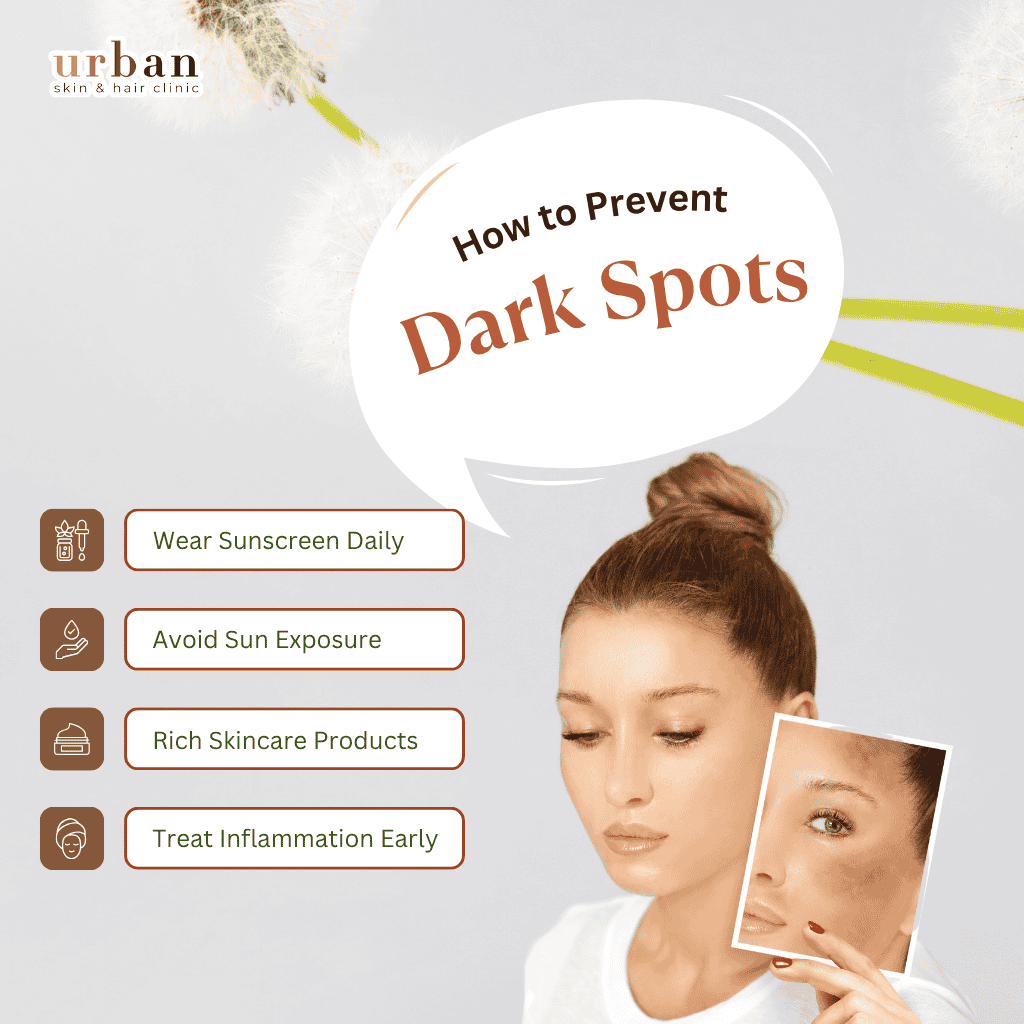
How to Prevent Dark Spots
- Wear Sunscreen Daily: Use a broad-spectrum sunscreen with SPF 30 or higher every day to protect against harmful UV rays.
- Avoid Excessive Sun Exposure: Limit your time in the sun, particularly during peak hours, to reduce the risk of developing dark spots.
- Use Antioxidant-Rich Skincare Products: Skincare products containing Vitamin C and niacinamide can help prevent pigmentation and brighten the skin.
- Treat Inflammation Early: Address any skin irritations or injuries promptly to prevent post-inflammatory hyperpigmentation.
- Be Cautious with Skincare Products: Avoid using harsh products that could irritate your skin or cause pigmentation changes.
We offer a variety of treatments designed to lighten dark spots and restore an even skin tone. Our dermatologists will tailor a treatment plan based on your skin type and the severity of the pigmentation.
- Laser Treatments (Q-Switched Laser, Fractional Laser): Laser therapy can target pigment deep within the skin, breaking it down to reduce dark spots and even out skin tone.
- Chemical Peels: Medical-grade peels exfoliate the skin, remove dead cells, and reduce pigmentation, revealing brighter skin underneath.
- Microneedling: This treatment uses tiny needles to stimulate collagen production and enhance the absorption of brightening serums, improving skin texture and tone.
- HydraFacial: A non-invasive facial treatment that exfoliates, hydrates, and brightens the skin, helping to fade dark spots over time.
- PRP (Platelet-Rich Plasma) Therapy: Using your own plasma, this treatment stimulates skin rejuvenation and helps lighten pigmentation while improving texture and tone.
- Topical Brightening Serums: Prescription-strength serums containing ingredients like Vitamin C, hydroquinone, and retinoids can lighten dark spots over time.
- Skin Lightening Treatments: We use advanced treatments designed specifically to target dark spots, utilizing ingredients that inhibit melanin production and brighten the skin.
Each treatment plan is customized to ensure optimal results, with ongoing maintenance to keep your skin clear and radiant.
Treatment Options at Urban Skin and Hair Clinic
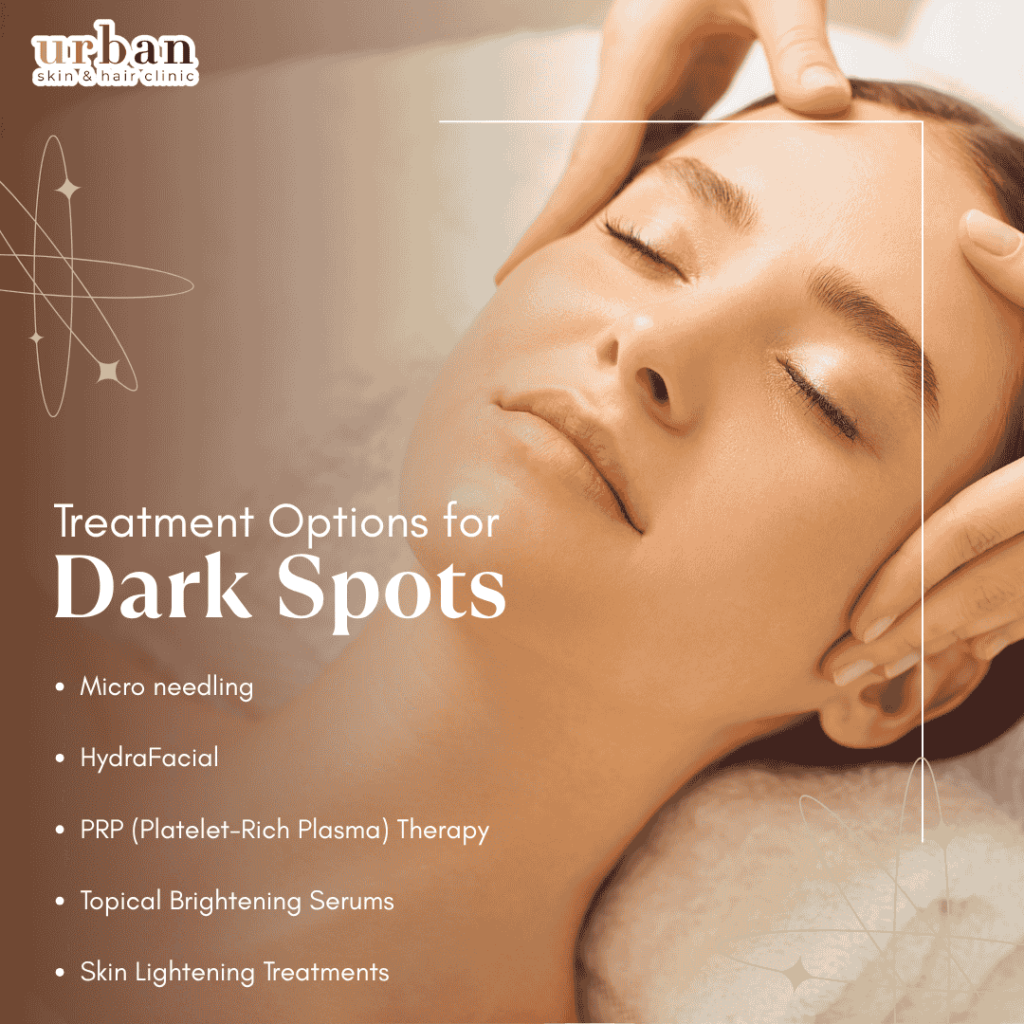
How to Find the Best Dark Spot Treatment Center?
- Expertise of the Practitioners: Look for a treatment centre that has qualified and experienced dermatologists or skincare specialists who specialize in treating dark spots. They should have in-depth knowledge of various treatment options and be skilled in performing procedures specific to dark spot removal. Research the qualifications, certifications, and years of experience of the practitioners to ensure they are highly trained in this field.
- Range of Treatment Options: A reputable treatment center should offer a comprehensive range of treatment options for dark spot removal. This ensures that they can tailor the treatment to your specific needs, considering factors such as the type and severity of your dark spots, your skin type, and any underlying conditions. Look for centres that offer a variety of treatments, including topical creams, chemical peels, laser therapies, and other advanced procedures.
- Advanced Technology and Techniques: Stay updated on the latest advancements in dark spot treatment and inquire about the technology and techniques used at the treatment centre. Look for centres that invest in state-of-the-art equipment and stay current with the latest research and developments in the field. Advanced technology can enhance the effectiveness of the treatment and minimize potential side effects.
- Positive Reviews and Testimonials: Take the time to read reviews and testimonials from previous patients who have undergone dark spot treatment at the centre you are considering. Look for feedback regarding the overall experience, results achieved, and the professionalism of the staff. Positive reviews and satisfied customers are a good indication of the quality of service provided by the treatment centre.
- Consultation and Customized Treatment Plans: A reliable treatment centre will offer a consultation where you can discuss your concerns and goals with the practitioner. During this consultation, the practitioner should conduct a thorough assessment of your skin, analyse your dark spots, and provide a personalized treatment plan tailored to your specific needs. They should explain the various treatment options available, along with their benefits, risks, and expected outcomes.
- Safety and Hygiene Practices: Safety should be a top priority at any reputable treatment center. Inquire about the hygiene practices followed at the facility, including sterilization protocols, cleanliness of the treatment rooms, and adherence to safety guidelines. Ensure that the center maintains a clean and safe environment to minimize the risk of infections or complications.
- Transparent Pricing and Packages: Obtain detailed information about the pricing structure and any treatment packages offered by the centre. It is important to have a clear understanding of the costs involved, including any additional charges for follow-up visits or post-treatment care. A reliable treatment centre will provide transparent pricing information and discuss payment options upfront.
- Client Education and Support: Look for a treatment center that prioritizes client education and support. The staff should be knowledgeable and willing to answer your questions, address your concerns, and provide guidance throughout your treatment journey. They should offer post-treatment care instructions and be available for follow-up consultations as needed.
Dark Spot Treatment Procedure
- Topical Treatments: Topical creams, gels, or serums containing ingredients such as hydroquinone, retinoids, vitamin C, kojic acid, or azelaic acid can be applied directly to the affected areas. These products work by inhibiting melanin production and promoting skin cell turnover, gradually fading the dark spots over time. It’s important to follow the instructions provided by the dermatologist or skincare professional and use sunscreen daily to protect the treated areas from sun damage.
- Chemical Peels: Chemical peels involve the application of a chemical solution to the skin, which causes the top layer of the skin to peel off, revealing a fresh layer underneath. This helps to lighten the dark spots and improve overall skin texture. Superficial or medium-depth peels containing ingredients like alpha-hydroxy acids (AHAs), beta-hydroxy acids (BHAs), or trichloroacetic acid (TCA) are commonly used for dark spot treatment. The depth and strength of the peel will depend on the severity of the dark spots and the desired outcome.
- Laser Therapy: Laser treatments use concentrated beams of light to target and break down the excess melanin in the skin. Different types of lasers, such as Q-switched lasers or fractional lasers, may be used for dark spot treatment. The laser energy selectively targets the pigmented areas while sparing the surrounding skin. The heat generated by the laser helps to destroy the melanin, resulting in the gradual lightening of the dark spots. Laser therapy is a precise and effective treatment option, but multiple sessions may be required for optimal results.
- Intense Pulsed Light (IPL): IPL treatment uses broad-spectrum light pulses to target and reduce pigmentation irregularities, including dark spots. The light energy is absorbed by the melanin in the skin, breaking it down and stimulating collagen production. IPL treatments can help fade dark spots, even out skin tone, and improve overall skin texture. It is a non-invasive procedure that typically requires multiple sessions for best results.
- Microdermabrasion: Microdermabrasion is a non-invasive exfoliation technique that involves the use of a handheld device to gently remove the top layer of the skin. This process helps to lighten the appearance of dark spots by stimulating cell turnover and promoting the growth of new, healthier skin cells. Microdermabrasion is a relatively gentle procedure and may require multiple sessions to achieve the desired results.
Benefits of Dark Spot Treatment
- Lightens Dark Spots: The primary benefit of dark spot treatment is the lightening and reduction of dark spots on the skin. Whether caused by sun damage, hormonal changes, acne scars, or other factors, dark spots can be unsightly and affect one’s self-confidence. Dark spot treatments target the excess melanin in the affected areas, gradually fading the dark spots and restoring a more even complexion.
- Evens Skin Tone: Dark spots can create an uneven skin tone, making the complexion appear blotchy or discolored. Dark spot treatment helps to even out the skin tone by reducing the intensity of pigmentation irregularities. By addressing the dark spots, the treatment promotes a more uniform distribution of melanin, resulting in a smoother and more balanced skin tone.
- Boosts Confidence: Hyperpigmentation, particularly on visible areas such as the face, can have a significant impact on self-esteem and confidence. Dark spot treatment can help individuals feel more confident about their appearance by reducing the visibility of dark spots and enhancing overall skin tone. Achieving a clearer and more even complexion can positively affect self-perception and improve overall well-being.
- Enhances Skin Texture: Some dark spot treatment procedures, such as chemical peels or microdermabrasion, also offer the additional benefit of improving skin texture. These treatments exfoliate the skin, removing dead skin cells and stimulating collagen production. As a result, the skin becomes smoother, softer, and more radiant. The combination of reducing dark spots and improving skin texture can lead to a youthful and rejuvenated appearance.
- Customizable Treatment Options: Dark spot treatment offers a range of customizable options to suit individual needs and preferences. Depending on the severity of the dark spots, skin type, and desired outcomes, various treatment modalities can be employed. From topical creams and serums to advanced laser or light-based therapies, individuals can work with their dermatologist or skincare professional to choose the most suitable treatment approach.
- Non-Invasive or Minimally Invasive: Many dark spot treatment procedures are non-invasive or minimally invasive, meaning they do not require surgical intervention or extensive downtime. Non-invasive treatments like topical creams, microdermabrasion, or certain laser therapies typically have minimal discomfort and allow individuals to resume their daily activities immediately. Minimally invasive procedures, such as chemical peels or certain laser treatments, may involve a short recovery period but are generally well-tolerated.
Side effects of Dark Spot Treatment
- Redness and Irritation: Following dark spot treatment, some individuals may experience temporary redness and irritation in the treated area. This can be a normal response to certain procedures, such as chemical peels or laser treatments. The skin may appear flushed or feel slightly sensitive for a few hours or days after the procedure. However, these effects typically subside on their own.
- Dryness and Peeling: Certain treatments, such as chemical peels or topical retinoids, may cause dryness and peeling of the skin. This is a normal part of the skin’s healing process and can be managed with moisturizers and gentle skincare products. It’s important to follow the aftercare instructions provided by your dermatologist or skincare professional to minimize dryness and promote proper skin healing.
- Sensitivity to Sunlight: After undergoing dark spot treatment, the treated area may become more sensitive to sunlight. This is especially true for procedures involving laser or light-based therapies. It is crucial to protect your skin from sun exposure by wearing broad-spectrum sunscreen with a high SPF, using protective clothing, and avoiding direct sunlight during peak hours. Failure to protect your skin adequately can lead to increased pigmentation or other complications.
- Temporary Darkening or Lightening of the Skin: In some cases, dark spot treatment may cause temporary changes in skin pigmentation. This can manifest as either darkening or lightening of the treated area. These pigmentary changes are usually transient and resolve over time. It’s important to discuss these potential effects with your dermatologist or skincare professional to understand what to expect and how long the changes may persist.
- Scarring: While rare, some individuals may experience scarring as a result of certain aggressive or invasive dark spot treatment procedures. This is more commonly associated with deep chemical peels or surgical excision of dark spots. It’s essential to choose a qualified and experienced professional for such procedures to minimize the risk of scarring. Proper post-treatment care and adherence to the provided instructions can also help reduce the likelihood of scarring.
Pre-Care for Dark Spot Treatment
- Consultation with a Dermatologist: Schedule a consultation with a qualified dermatologist or skincare professional specializing in dark spot treatment. They will assess your skin condition, discuss your treatment goals, and recommend the most suitable treatment options for your specific needs.
- Avoid Sun Exposure: Minimize your sun exposure in the weeks leading up to the treatment. Sun exposure can stimulate melanin production, which can interfere with the desired effects of the dark spot treatment. If you need to go outside, ensure that you use broad-spectrum sunscreen with a high SPF, wear protective clothing, and seek shade whenever possible.
- Discontinue Certain Medications: Inform your dermatologist about any medications or skincare products you are currently using. Some medications, such as retinoids or acne medications, may need to be temporarily discontinued before the treatment to reduce the risk of skin sensitivity or adverse reactions. Follow your dermatologist’s instructions regarding any necessary medication adjustments.
- Avoid Skin Irritants: Refrain from using any harsh skincare products or exfoliants on the treatment area for at least a week prior to the procedure. These products can irritate the skin and make it more sensitive to the treatment. Stick to gentle cleansers and moisturizers recommended by your dermatologist.
- Disclose Medical History: Inform your dermatologist about any pre-existing medical conditions, allergies, or previous skin treatments you have undergone. This information will help your dermatologist assess your suitability for dark spot treatment and make any necessary adjustments to ensure your safety and optimal results.
- Follow Instructions for Skincare Products: Your dermatologist may recommend specific skincare products to prepare your skin for the treatment. Follow their instructions on when and how to use these products to cleanse, moisturize, and protect your skin leading up to the procedure.
- Stay Hydrated: Maintain good hydration by drinking plenty of water in the days leading up to the treatment. Hydrated skin tends to heal better and can improve the overall outcome of the dark spot treatment.
- Follow a Healthy Lifestyle: Prioritize a healthy lifestyle by eating a balanced diet, getting regular exercise, and managing stress levels. A healthy lifestyle can contribute to the overall health and resilience of your skin, aiding in the healing process and enhancing the results of the dark spot treatment.
After Care Dark Spot Treatment
- Follow Post-Treatment Instructions: Your dermatologist or skincare professional will provide you with specific post-treatment instructions tailored to your procedure. It is important to carefully follow these instructions for optimal healing and to minimize the risk of complications.
- Protect Your Skin from the Sun: After dark spot treatment, your skin may be more sensitive to the sun’s harmful rays. It is crucial to protect your skin by wearing broad-spectrum sunscreen with a high SPF, even on cloudy days. Reapply sunscreen every two hours, or as directed by your dermatologist. Additionally, wear protective clothing, such as hats and long sleeves, and seek shade whenever possible.
- Avoid Picking or Scratching: It is important to resist the urge to pick or scratch the treated area. Doing so can disrupt the healing process and increase the risk of infection or scarring. Let the skin heal naturally and avoid any aggressive or abrasive skincare products on the treated area.
- Keep the Area Clean: Gently cleanse the treated area with a mild, non-irritating cleanser as recommended by your dermatologist. Avoid using harsh or fragranced products that may irritate the skin. Pat the area dry with a clean towel, being careful not to rub or tug on the skin.
- Moisturize Regularly: Apply a gentle and hydrating moisturizer to the treated area to keep the skin moisturized and promote healing. Look for products specifically formulated for sensitive or post-treatment skin. Consult with your dermatologist for suitable recommendations.
- Avoid Excessive Heat or Cold: Avoid exposing the treated area to excessive heat, such as saunas, hot tubs, or hot showers, as it can increase inflammation and discomfort. Similarly, avoid extreme cold temperatures, as this can also be irritating to the treated skin.
- Avoid Harsh Chemicals or Exfoliants: Refrain from using harsh skincare products, exfoliants, or treatments that may irritate or disrupt the healing process. Stick to gentle skincare routines and products recommended by your dermatologist until the skin has fully healed.
- Attend Follow-Up Appointments: Schedule and attend any recommended follow-up appointments with your dermatologist or skincare professional. These appointments allow them to monitor your progress, address any concerns, and provide additional guidance if needed.
- Be Patient: It’s important to remember that the results of dark spot treatment may take time to fully manifest. Your skin needs time to heal, and the dark spots may gradually fade over several weeks or months. Be patient and consistent with your aftercare routine to optimize the outcomes of the treatment.
Consult a Specialist Today
Dr. Kiran Chotaliya, M.D., Dermatology & Hair Transplant Surgeon, is a highly skilled dermatologist specializing in pigmentation treatments. With years of experience and a patient-first approach, Dr. Chotaliya ensures that every treatment plan is tailored to meet your individual skin needs for safe and effective results.
FAQ for Dark Spot Treatment
Patients typically see visible results within 4-6 weeks, though it may take longer depending on the severity of the dark spots.
Yes, our treatments are safe for all skin types, and we tailor them to your specific needs, ensuring the best results.
While dark spots can be minimized or removed, they may return if the underlying causes (such as sun exposure or hormonal imbalances) are not addressed. Sunscreen and proper skincare are essential to maintain results.
The number of sessions depends on the severity of the pigmentation. Most patients require 4-6 sessions for optimal results, spaced a few weeks apart.
Depending on the treatment, there may be mild redness or sensitivity for a short period. However, most treatments require little to no downtime.
Why Urban Skin and Hair Clinic

TEAM OF CERTIFIED DERMATOLOGISTS

US-FDA APPROVED EQUIPMENTS

HIGHLY STANDARDISED PROTOCOLS

1 LAKH + HAPPY CLIENTS
Dark Spot Treatment Results Before & After
